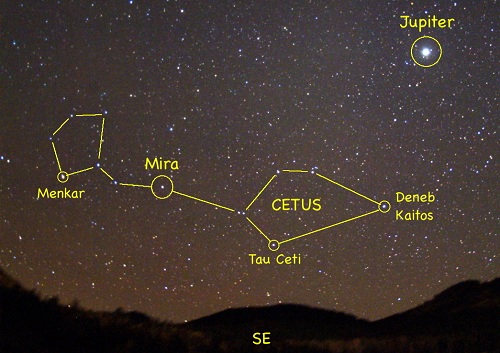'Habitable' planet discovered circling Tau Ceti star

World is one of five thought to be circling star just 12 light years away, say scientists
A planet with conditions that could
support life orbits a twin neighbour of the sun visible to the naked
eye, scientists have revealed.
The world is one of five thought to be circling Tau Ceti, a star just 12 light years away that is almost identical to the sun.
Astronomers estimate the Tau Ceti planets to be two to six times bigger than Earth. One of them, with five times the Earth's mass, lies in the star's "habitable zone".
Also known as the "Goldilocks zone", this is the orbital region that is neither too hot nor too cold to allow liquid surface water and, potentially, life. Details of the discovery are to appear in the journal Astronomy & Astrophysics.
Because of the difficulties involved in detecting extra-solar planets, most found so far have had high masses. The Tau Ceti planetary family is thought to be the lowest-mass solar system yet detected.
Scientists found the planets using a highly sensitive technique that combined data from more than 6,000 observations from three different telescopes. They used the radial velocity method, which looks for "wobble" in a star's movement caused by the gravitational tug of planets.
Dr James Jenkins, a member of the international team from the University of Hertfordshire, said: "Tau Ceti is one of our nearest cosmic neighbours and so bright that we may be able to study the atmospheres of these planets in the not-too-distant future.
"Planetary systems found around nearby stars close to our sun indicate that these systems are common in our Milky Way galaxy."
More than 800 planets have been discovered orbiting stars beyond the sun since the 1990s. Those found around the nearest sun-like stars are the most interesting to astronomers.
Professor Steve Vogt, another team member, from the University of California at Santa Cruz, said: "This discovery is in keeping with our emerging view that virtually every star has planets, and that the galaxy must have many such potentially habitable Earth-sized planets. They are everywhere, even right next door."
Professor Chris Tinney, an Australian member from the University of New South Wales, said: "As we stare at the night sky, it is worth contemplating that there may well be more planets out there than there are stars, some fraction of which may well be habitable."
Jenkins is a visiting fellow at the University of Hertfordshire who is based at the University of Chile.
http://www.centauri-dreams.org/?p=25935
http://news.discovery.com/space/five-planets-one-in-habitable-zone-...
The world is one of five thought to be circling Tau Ceti, a star just 12 light years away that is almost identical to the sun.
Astronomers estimate the Tau Ceti planets to be two to six times bigger than Earth. One of them, with five times the Earth's mass, lies in the star's "habitable zone".
Also known as the "Goldilocks zone", this is the orbital region that is neither too hot nor too cold to allow liquid surface water and, potentially, life. Details of the discovery are to appear in the journal Astronomy & Astrophysics.
Because of the difficulties involved in detecting extra-solar planets, most found so far have had high masses. The Tau Ceti planetary family is thought to be the lowest-mass solar system yet detected.
Scientists found the planets using a highly sensitive technique that combined data from more than 6,000 observations from three different telescopes. They used the radial velocity method, which looks for "wobble" in a star's movement caused by the gravitational tug of planets.
Dr James Jenkins, a member of the international team from the University of Hertfordshire, said: "Tau Ceti is one of our nearest cosmic neighbours and so bright that we may be able to study the atmospheres of these planets in the not-too-distant future.
"Planetary systems found around nearby stars close to our sun indicate that these systems are common in our Milky Way galaxy."
More than 800 planets have been discovered orbiting stars beyond the sun since the 1990s. Those found around the nearest sun-like stars are the most interesting to astronomers.
Professor Steve Vogt, another team member, from the University of California at Santa Cruz, said: "This discovery is in keeping with our emerging view that virtually every star has planets, and that the galaxy must have many such potentially habitable Earth-sized planets. They are everywhere, even right next door."
Professor Chris Tinney, an Australian member from the University of New South Wales, said: "As we stare at the night sky, it is worth contemplating that there may well be more planets out there than there are stars, some fraction of which may well be habitable."
Jenkins is a visiting fellow at the University of Hertfordshire who is based at the University of Chile.
http://www.centauri-dreams.org/?p=25935
http://news.discovery.com/space/five-planets-one-in-habitable-zone-...

Geen opmerkingen:
Een reactie posten